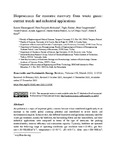Mostrar o rexistro simple do ítem
Bioprocesses for resource recovery from waste gases: Current trends and industrial applications
| dc.contributor.author | Khanongnuch, Ramita | |
| dc.contributor.author | Nalakath Abubackar, Haris | |
| dc.contributor.author | Keskin Gundogdu, Tugba | |
| dc.contributor.author | Güngörmüşler, Mine | |
| dc.contributor.author | Duman, Gozde | |
| dc.contributor.author | Agrawal, Ayushi | |
| dc.contributor.author | Behera, Shishir Kumar | |
| dc.contributor.author | Li, Lu | |
| dc.contributor.author | Bayar, Büşra | |
| dc.contributor.author | Rene, Eldon R. | |
| dc.date.accessioned | 2022-03-04T14:20:31Z | |
| dc.date.issued | 2021-12-27 | |
| dc.identifier.citation | Khanongnuch R, Abubackar HN, Keskin T, Gungormusler M, Duman G, Aggarwal A, et al. Bioprocesses for resource recovery from waste gases: Current trends and industrial applications. Renewable and Sustainable Energy Reviews 2022;156:111926. | es_ES |
| dc.identifier.issn | 1364-0321 | |
| dc.identifier.uri | http://hdl.handle.net/2183/29883 | |
| dc.description.abstract | [Abstract] Air pollution is a topic of important global concern because it has contributed significantly to an increase in the earth's global warming potential and contributed to severe health and environmental impacts. In this review, the different bioreactor configurations commonly used for waste gas treatment, namely the biofilters, the biotrickling filters and the bioscrubbers, and their industrial applications were compared in terms of the type of inoculum, the packing material/media, removal efficiency and elimination capacity. Typically, biofilters are operated under the following range of operating conditions: gas residence time = 15–60 s; gas flow rate = 50–300,000 m3 h−1; temperature = 15–30 °C; pH = 6.0–7.5; filter area = 100–3000 m2; relative humidity >95.0%; and removal efficiencies >75.0% depending on the waste gas composition and concentration. The biotechnological approaches for resource recovery, i.e., the conversion of C1 gaseous compounds (CO, CO2 and CH4) to liquified value-added products or biofuels have been discussed. From this review, it was evident that the performances of different aerobic, anoxic and/or anaerobic lab, pilot and full-scale bioreactors for waste gas treatment and resource recovery depend on the composition, the individual concentration of pollutants present in the waste gas and the gas flow rate. Although most of the research on product recovery from waste gas is rather limited to lab/pilot-scale studies, there are some key commercialized technologies that have proven to be economical at the full-scale. Thus, this review, comprehensively presents a complete overview of the current trends and limitations of conventional waste gas treatment systems, the benefits of novel bioreactor configurations and their potential to be applied for resource recovery from waste gases. | es_ES |
| dc.description.sponsorship | RK acknowledges Antti Rissanen for her postdoctoral fellowship from the Kone Foundation, Finland [grant number 201803224]. TK, GD and HNA would like to acknowledge the Scientific and Technological Research Council of Turkey (TUBITAK-CAYDAG) [grant number 118Y305] for providing financial support. MG, TK and HNA would like to acknowledge TUBITAK-CAYDAG [grant number 120Y069] for the financial support. HNA also thanks the Xunta de Galicia (Spain) for his postdoctoral fellowship (ED481D 2019/033). BB thanks Xunta de Galicia (Spain) for her predoctoral fellowship (ED481A-2020/226). SKB is grateful to Vellore Institute of Technology, Vellore, India for providing the necessary infrastructural and staff time support to carry out this research work. ERR thanks the IHE Delft Institute for Water Education for providing staff time and infrastructural support to collaborate with other researchers on this project. The authors would like to thank BioRender for providing an easy to use tool to prepare the schematics of the bioreactors. | es_ES |
| dc.description.sponsorship | Finlandia. Kone Foundation; 201803224 | es_ES |
| dc.description.sponsorship | Turquía. Scientific and Technological Research Council; 118Y305 | es_ES |
| dc.description.sponsorship | Turquía. Scientific and Technological Research Council; 120Y069 | es_ES |
| dc.description.sponsorship | Xunta de Galicia; ED481D 2019/033 | es_ES |
| dc.language.iso | eng | es_ES |
| dc.publisher | Elsevier | es_ES |
| dc.relation.uri | https://doi.org/10.1016/j.rser.2021.111926 | es_ES |
| dc.rights | Atribución-NoComercial-SinDerivadas 3.0 España | es_ES |
| dc.rights.uri | http://creativecommons.org/licenses/by-nc-nd/3.0/es/ | * |
| dc.subject | Waste gas | es_ES |
| dc.subject | Bioreactors | es_ES |
| dc.subject | Volatile pollutants | es_ES |
| dc.subject | Syngas fermentation | es_ES |
| dc.subject | Elimination capacity | es_ES |
| dc.subject | Resource recovery | es_ES |
| dc.title | Bioprocesses for resource recovery from waste gases: Current trends and industrial applications | es_ES |
| dc.type | info:eu-repo/semantics/article | es_ES |
| dc.rights.access | info:eu-repo/semantics/openAccess | es_ES |
| dc.date.embargoEndDate | 2023-12-27 | es_ES |
| dc.date.embargoLift | 2023-12-27 | |
| UDC.journalTitle | Renewable and Sustainable Energy Reviews | es_ES |
| UDC.volume | 156 | es_ES |
| UDC.startPage | 111926 | es_ES |
Ficheiros no ítem
Este ítem aparece na(s) seguinte(s) colección(s)
-
GI-BIOENGIN- Artigos [91]






